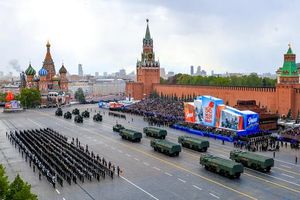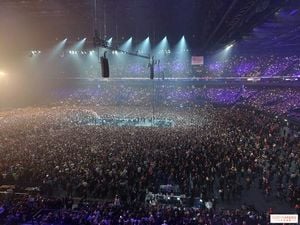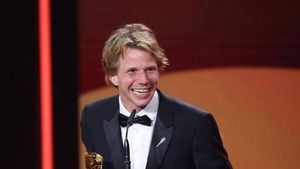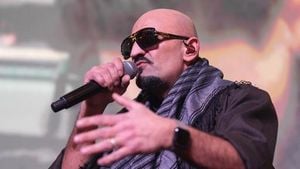On Thursday, May 8, 2025, cardinals gathered in the Sistine Chapel for the second day of the conclave to elect a new pope, following two rounds of voting that resulted in black smoke, signaling that no new pontiff has yet been chosen. The anticipation surrounding the voting is palpable, especially since the last two popes were announced on their second day of voting.
Out of a total of 252 cardinals, only those under the age of 80 are eligible to participate in the papal conclave. Currently, 135 cardinals meet this age criterion, although two have opted not to travel to Rome due to health issues, reducing the number of confirmed voting participants to 133. To elect a new pope, a two-thirds majority is required, which translates to 89 votes out of the 133 eligible cardinals. If no candidate reaches this threshold, another vote ensues. After each round of voting, the ballots are burned. Black smoke rising from the chimney atop the Sistine Chapel indicates no pope has been elected, while white smoke signals the election of a new pontiff.
According to Father Francis Lucas, a Catholic priest and executive director of the Catholic Media Network, the method for producing smoke has evolved over time. “In the past, fresh straw was used to produce white smoke, and water was added to produce black smoke,” he explained to Al Jazeera. “However, this sometimes resulted in grey smoke, which led to confusion. Now, chemicals are added to ensure the smoke is distinctly black or white.”
The voting process during the conclave is both solemn and structured. After the first day, voting occurs a maximum of four times daily: twice in the morning and twice in the afternoon. Each cardinal receives a ballot marked “Eligo in Summum Pontificem” (“I elect as Supreme Pontiff”) and writes in their chosen candidate. They are not allowed to vote for themselves. The cardinals then fold their ballots, hold them up for visibility, and carry them to the altar, where a chalice covered by a plate awaits. One by one, the cardinals approach the altar before Michelangelo’s Last Judgement, swear an oath, and place their votes in the chalice.
Each cardinal recites the oath aloud in Italian: “Chiamo a testimone Cristo Signore, il quale mi giudicherà, che il mio voto è dato a colui che, secondo Dio, ritengo debba essere eletto,” which translates to “I call as my witness Christ the Lord, who will be my judge, that my vote is given to the one whom I believe should be elected according to God.” For those unable to walk to the altar due to illness, their folded ballots are given to scrutineers—cardinals tasked with overseeing the voting—who then deposit them in the chalice.
Outside the chapel, a number of personnel handle logistics, security, and medical support, with about 100 additional individuals having taken an oath of secrecy beyond the voting cardinals. When they are not voting, the cardinals typically move by charter bus around St. Peter’s to the Sistine Chapel for their morning vote, return to the Domus Sanctae Marthae (Saint Martha’s House) for meals and naps, and then head back for the evening vote.
The dining experience during the conclave has been described as ordinary, with meals consisting primarily of pasta, soup, and fruit. This simplicity aligns with Pope Francis's focus on humility. A Vatican insider shared with the UK’s Times that the food is “pretty ordinary,” and some cardinals have complained about the blandness of the dishes. Cardinal Gianfranco Ravasi of Italy, a supporter of Pope Francis, remarked, “You don’t eat very well.”
Interestingly, Pope Francis himself broke with a long-standing tradition by choosing to reside in a simple suite at Santa Marta instead of the lavish papal apartments in the Apostolic Palace. “This room where we are now was a guest room,” Pope Francis explained in an interview. “I chose to live here, in Room 201… The papal apartment in the Apostolic Palace is not luxurious. It is old, tastefully decorated and large, but not luxurious.”
As the cardinals continue their deliberations, the stakes remain high. Cultural anthropologist Marc Loustau spoke on FRANCE 24's Perspective program, emphasizing the challenges the next pope will face. He stated that the new pontiff will need “a steady diplomatic hand” amid a changing global order. Loustau noted that while Pope Francis attempted to use his moral authority to foster peace among warring parties, he ultimately fell short of achieving significant breakthroughs.
As the conclave unfolds, the world watches closely, eager to see who will emerge as the next leader of the Catholic Church. The process, steeped in tradition and solemnity, is not just about selecting a new pope but also about navigating the complexities of modern challenges facing the Church and its followers.
With the next round of voting approaching, the cardinals are likely reflecting on their previous votes and engaging in informal discussions during their time at Saint Martha’s House. It is here that alliances may form, and strategies may shift as they consider the qualities needed in the next pope. The outcome of this conclave is not merely a matter of tradition; it carries the weight of the Church's future in a rapidly changing world.



